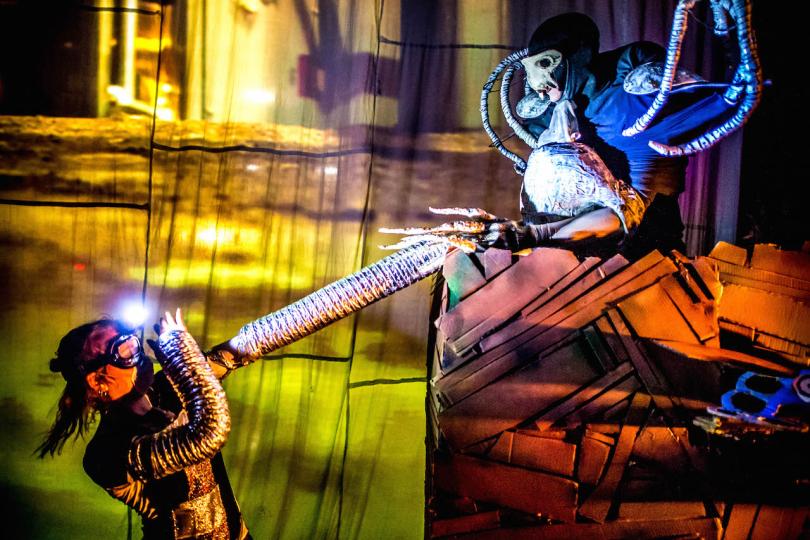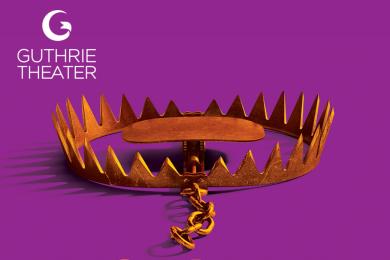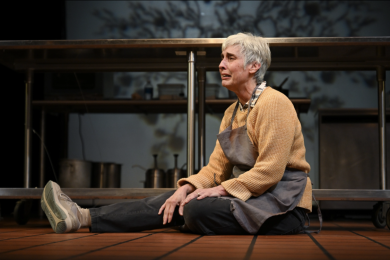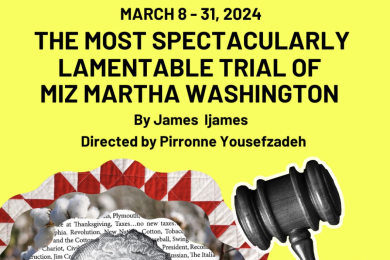Is this the world's next cult classic?

If you were to collect the most haunting musical segments from your favorite children’s films, live or animated, you might come up with Basement Creatures. Given its themes of remembering, searching, and excavating forgotten places, I would say that nostalgia factor is entirely deliberate. More comically creepy than outright scary, it’s made for older kids or adults or anyone who loves Halloween.
Basement Creatures grew out of last year’s PuppetLab, a fellowship designed to promote the work of emerging artists. Davey T Steinman’s original abridged pitch work was shown alongside Shari Aronson, Lelis Brito, and Jeong Ae Neal. After three sold out performances, the creators decided to expand the work and remount the play, with additional funding via Kickstarter.
Truly elaboratingly multi-media and more
The rock opera takes places on the backstage side of the curtain in Heart of the Beast, with an onstage band, an occasional choir, aerial acrobatics, puppets, video clips projected on the curtains, and good old dancing/singing actors. The puppets have human heads and puppet bodies, a style of puppetry sometimes called humanettes or living marionettes. Their limbs are controlled by stagehands in all black—these are the main actors turned anonymous. I want to call them kuroko in reference to Japanese stagehand theatre tradition and its contemporary application to Matrix Ping-Pong. There are similarly weightless effects in Basement Creatures: creatures toss their heads, display their innards, caress and seize with detached hands.
The human protagonist of Basement Creatures is played by Angie Courchaine and named the Subterranean Explorer. She descends by chain, silent but emotive, with a headlight on her forehead. The Basement Dweller, played by producer and creator Davey T. Steinman himself, is the narrator.
The frame of the story is a classic one: a young human enters a land of nonhumans (in this story, the Underground), witnesses their peculiarities, learns about herself, and must find the way home with her new knowledge. It’s a framework used in Labyrinth as well as the Phantom Tollbooth. The latter is directly referenced during the play as a favorite book of the narrator. The former is visually referenced when one of the characters forms a glowing UV-lit face in the style of the Labyrinth’s Helping Hands. You could classify this as the “Voyage and Return” out of the Seven Basic Plots.
Martian poetry?
This framework is inverted in that the human in this play is mysterious and unexplained while the narrator is one of the Others from the strange new world. The Basement Dweller is trying to understand the Subterranean Explorer, trying to understand humans. Its interpretations are like Martian poetry: full of unusual comparisons and original insights but also humorous misunderstandings and disorienting distances. Rather than any conflict, the story is driven by the implied search of the Subterranean Explorer—she does want something, doesn’t she? The Basement Dweller wonders aloud: what is she looking for? What does she want? What do humans want? What do humans do these things?
Other characters come and go with songs and skits that demonstrate the Basement Dweller’s questions and conclusions. The interactions are similar to those in Alice in Wonderland or any other fish-out-of-water tale: they are not so much crucial to the plot as much as they are amusing segments in their own right. They include a Basement Centipede protesting supremacy of the humans whose shoes stomp him; a Lonely Bedbug that seeks blood as a metaphor for love; a Knowledge Professor who teaches other creatures to fear the sun through a less-correct version of the 50s children’s record Why Does the Sun Shine? (Tom Glazer & Dottie Evans’ Space Songs), and more.
The songs and skits mix comedy with nods to topical issues and local settings. There are references to long Minnesota winters, boomerang children with intrusive parents, job searching in tough economies, polarized politics, and the difficulty of searching for love. The themes of the underground and undiscovered echo the lives of the experimental artists in the work as well. Steinman himself writes in the program that he intended to channel just enough real life into the surreal, and I think that is one of the story’s strengths. Like any good fiction, it’s got heart beneath the magic and reality behind the fantasy. None of the topical nods are specific enough to date it.
Not for children
The skits are strongest to me when they are light skewering of modern-day humans rather than silly for the sake of being silly. The segment most baffling to me is the “Feed Me” video, in which Steinman slathers himself with food to a wordless remix of Gangnam Style. I suppose it can be read as a criticism of capitalism or consumerism, but even then, it seems to be a tonal misfit with the rest of the piece.
That was one of a several scenes that established the play as something other than children’s entertainment. Another was a timely song on politics suggesting that all political opinions are the wrong ones. No matter what you think, you should go to hell. Given that the catchy song also has a group dance, it may be the soundtrack’s Time Warp.
In another not PG moment, a character undresses to reveal his puppetness: his human hands, innards, and beating heart. It was my favorite segment, despite it being one of the sillier songs least related to the overall theme of self-discovery. Even if the theme was weak, the singing was strong, the acting and puppetry both engaging.
The puppets and costumes occupy a creepy-crawly sweet spot, where the eyes accept their textures as carapaces, exoskeletons, or whatever weird body unnerves us in the right way. The lighting grows fierce or weak to accent the mood. Together, it creates a sum greater than its parts.
And there are a lot of parts: live theatre, aerial acrobatics, live music, video, puppetry. I can’t say that Basement Creatures will definitely become a cult hit, but that seems its aim. It has a soundtrack CD and other merchandise available for sale, but most of all, it has ambition. The result is eclectic and fun, a uniquely live experience.




